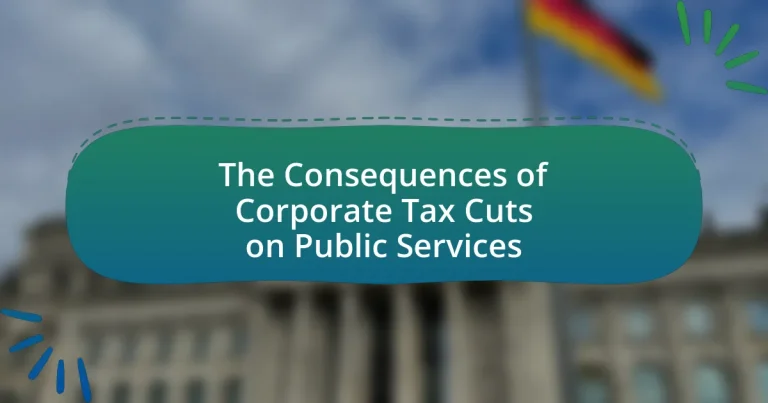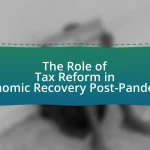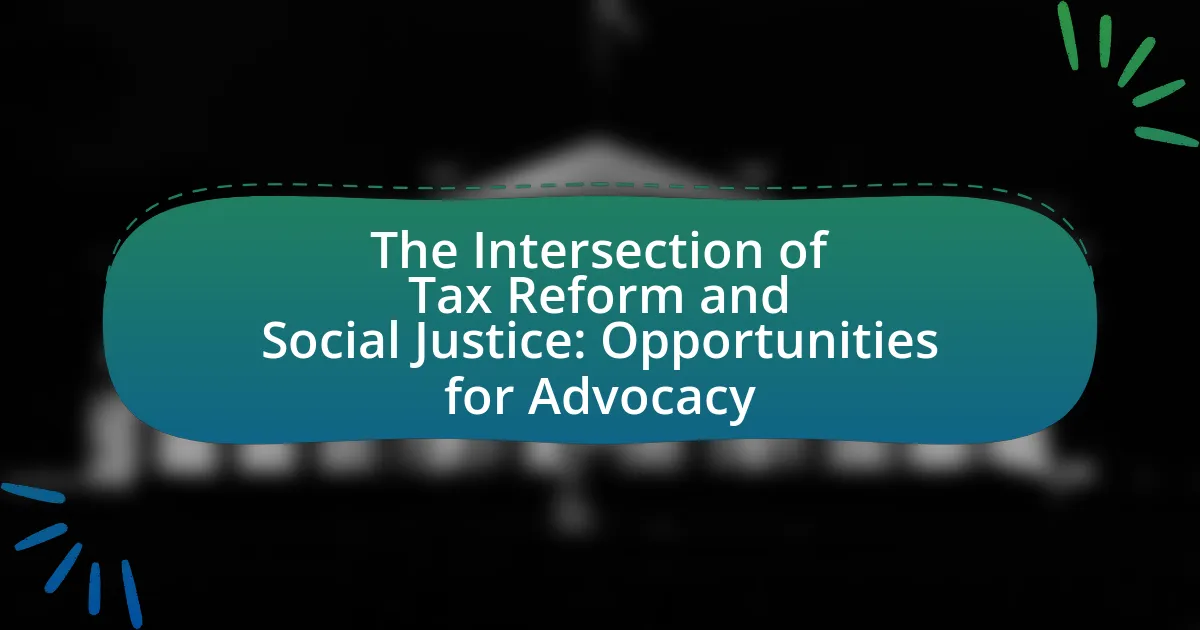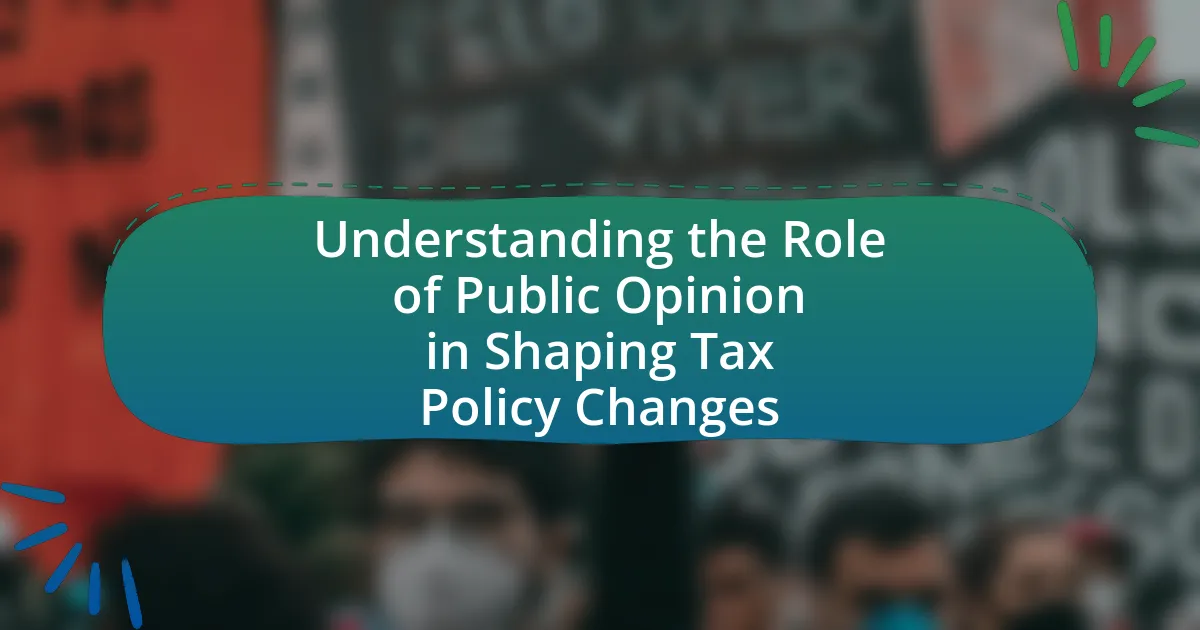The article examines the consequences of corporate tax cuts on public services, highlighting how reductions in corporate tax rates lead to decreased government revenue and subsequent budget cuts for essential services such as education, healthcare, and infrastructure. It discusses both short-term and long-term impacts, including immediate funding constraints and the deterioration of service quality over time. Additionally, the article addresses the potential benefits of tax cuts, such as economic growth and increased investment, while also critiquing the resulting income inequality and reduced public service funding. Case studies from states like Kansas and Wisconsin illustrate the adverse effects of tax cuts on public service availability and quality, emphasizing the need for balanced tax policies that consider revenue generation alongside public service funding.
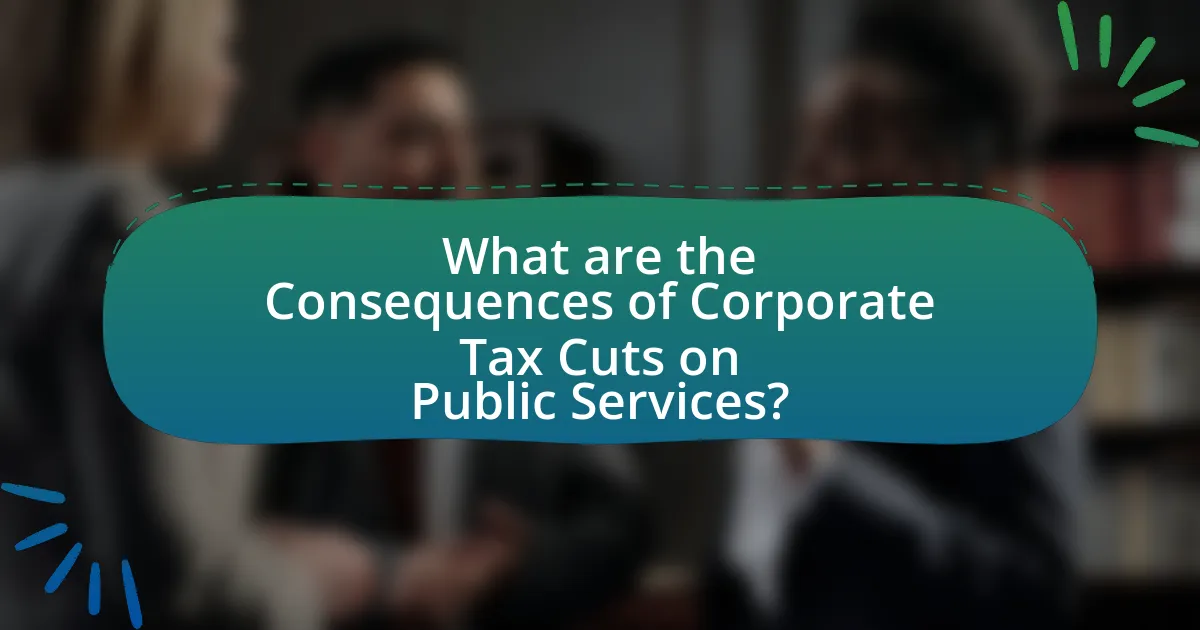
What are the Consequences of Corporate Tax Cuts on Public Services?
Corporate tax cuts often lead to reduced funding for public services. When governments decrease corporate tax rates, they typically experience a decline in revenue, which can result in budget cuts for essential services such as education, healthcare, and infrastructure. For instance, a study by the Institute on Taxation and Economic Policy found that states that implemented significant corporate tax cuts saw a corresponding decrease in public investment, leading to deteriorating public services. This trend indicates that while corporate tax cuts may stimulate business investment in the short term, they can undermine the quality and availability of public services in the long run.
How do corporate tax cuts impact government revenue?
Corporate tax cuts generally lead to a decrease in government revenue. When corporations pay lower taxes, the immediate effect is a reduction in the funds available for public services and government programs. For instance, a study by the Institute on Taxation and Economic Policy found that corporate tax cuts in the United States resulted in a revenue loss of approximately $1.5 trillion over a decade. This reduction in revenue can hinder the government’s ability to invest in essential services such as education, healthcare, and infrastructure, ultimately impacting public welfare.
What are the short-term effects on public service funding?
Short-term effects on public service funding include immediate budget constraints and reduced financial resources for essential services. Following corporate tax cuts, governments often experience a decrease in revenue, which can lead to cuts in funding for public services such as education, healthcare, and infrastructure. For instance, a study by the Institute on Taxation and Economic Policy found that states that implemented corporate tax cuts saw an average revenue decline of 10% in the first year, directly impacting public service budgets. This reduction can result in layoffs, decreased service availability, and delayed projects, affecting the overall quality of public services provided to citizens.
How do long-term revenue changes affect public services?
Long-term revenue changes significantly impact public services by altering funding levels and service availability. When revenue decreases, often due to corporate tax cuts, governments may face budget shortfalls, leading to reduced investment in essential services such as education, healthcare, and infrastructure. For instance, a study by the Center on Budget and Policy Priorities found that states that implemented corporate tax cuts experienced a decline in public school funding, which negatively affected student outcomes. Conversely, stable or increasing revenues allow for enhanced public services, fostering community well-being and economic growth. Therefore, the relationship between long-term revenue changes and public services is critical, as it directly influences the quality and accessibility of services provided to the public.
What are the potential benefits of corporate tax cuts?
Corporate tax cuts can stimulate economic growth by increasing investment and job creation. When corporations face lower tax rates, they often reinvest the savings into their businesses, leading to expansion and the hiring of additional employees. For instance, a study by the National Bureau of Economic Research found that a 1% decrease in corporate tax rates can lead to a 0.5% increase in investment. Additionally, corporate tax cuts can enhance competitiveness, allowing companies to allocate more resources towards innovation and productivity improvements, which can further drive economic activity.
How might corporate tax cuts stimulate economic growth?
Corporate tax cuts can stimulate economic growth by increasing the after-tax profits of businesses, which encourages investment and expansion. When companies retain more earnings due to lower tax rates, they are more likely to invest in new projects, hire additional employees, and increase wages. For instance, a study by the Tax Foundation found that a 10% reduction in corporate tax rates could lead to a 1.5% increase in GDP over the long term. This increase in economic activity can result in higher consumer spending and improved overall economic performance.
What sectors could see increased investment due to tax cuts?
Sectors that could see increased investment due to tax cuts include technology, manufacturing, and renewable energy. Tax cuts often provide companies with additional capital, incentivizing them to invest in research and development, expand production capabilities, and adopt sustainable practices. For instance, a study by the Tax Foundation found that corporate tax reductions can lead to a 2.5% increase in investment in the technology sector, as firms allocate savings towards innovation and infrastructure. Similarly, the manufacturing sector benefits from lower operational costs, allowing for reinvestment in facilities and workforce. In renewable energy, tax incentives can drive significant capital into clean technology projects, as evidenced by a report from the International Renewable Energy Agency, which noted a 15% increase in investment in renewables following tax incentives in various countries.
What are the criticisms of corporate tax cuts regarding public services?
Critics argue that corporate tax cuts undermine public services by reducing government revenue, which is essential for funding education, healthcare, and infrastructure. For instance, a report by the Institute on Taxation and Economic Policy indicates that states that implemented significant corporate tax cuts experienced budget shortfalls, leading to cuts in essential services. Additionally, opponents contend that these tax reductions disproportionately benefit corporations and wealthy individuals, while the resulting budget constraints force local governments to raise taxes or cut services that disproportionately affect low-income communities. This dynamic creates a cycle of inequality, as public services are crucial for social mobility and community well-being.
How do tax cuts contribute to income inequality?
Tax cuts contribute to income inequality by disproportionately benefiting higher-income individuals and corporations, leading to a widening wealth gap. When tax cuts are implemented, they often favor those with greater financial resources, as they receive a larger share of the benefits compared to lower-income earners. For instance, the Tax Cuts and Jobs Act of 2017 in the United States primarily reduced corporate tax rates and provided significant tax breaks for wealthy individuals, resulting in an increase in after-tax income for the top earners while offering minimal relief to lower-income households. This shift in tax burden exacerbates income inequality, as the wealth accumulated by the affluent is not equitably redistributed, limiting economic mobility for lower-income groups.
What evidence exists linking tax cuts to reduced public service quality?
Evidence linking tax cuts to reduced public service quality includes studies showing that tax reductions often lead to budget cuts in essential services. For instance, a report by the Center on Budget and Policy Priorities indicates that states that implemented significant tax cuts experienced declines in funding for education and healthcare, resulting in larger class sizes and reduced access to medical services. Additionally, research published in the Journal of Public Economics found that tax cuts can lead to a decrease in public sector employment, which negatively impacts service delivery. These findings demonstrate a clear correlation between tax cuts and the deterioration of public service quality.
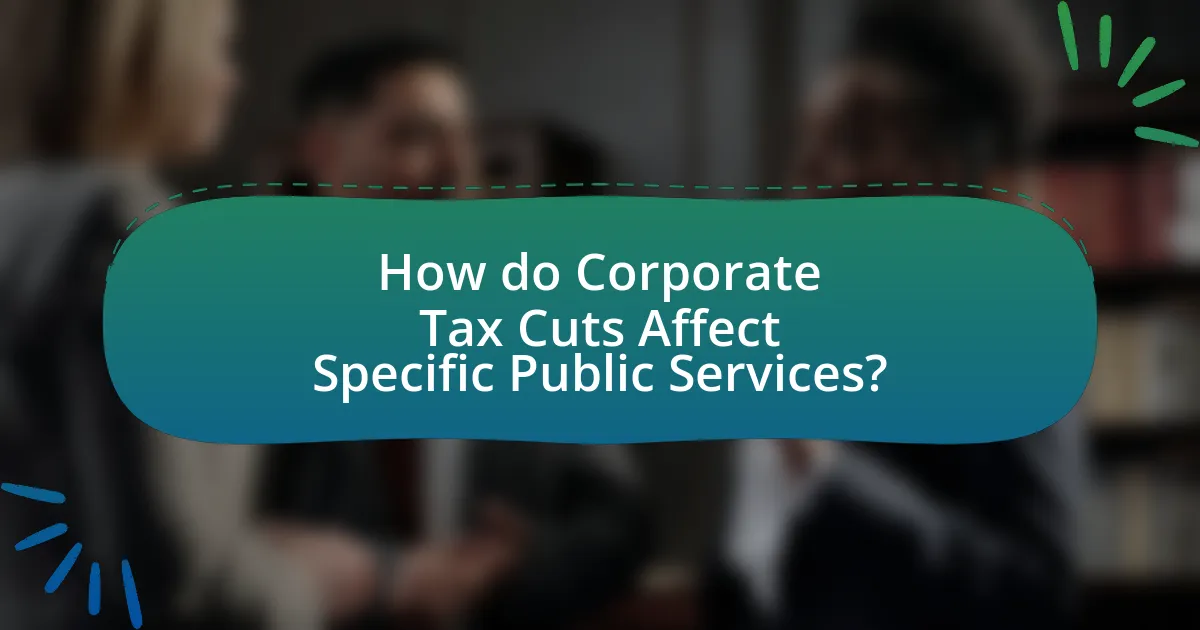
How do Corporate Tax Cuts Affect Specific Public Services?
Corporate tax cuts generally lead to reduced funding for specific public services. When governments lower corporate tax rates, they often experience a decrease in revenue, which can result in budget constraints for essential services such as education, healthcare, and infrastructure. For instance, a study by the Institute on Taxation and Economic Policy found that states that enacted corporate tax cuts saw a significant decline in public school funding, with some states reporting reductions of up to 20% in per-pupil spending. This reduction in funding can lead to larger class sizes, fewer resources for students, and diminished educational outcomes. Additionally, healthcare services may face cuts, leading to longer wait times and reduced access to care, as seen in various states that prioritized tax cuts over healthcare funding. Thus, corporate tax cuts can have a direct and detrimental impact on the quality and availability of public services.
What is the impact on education funding?
The impact on education funding due to corporate tax cuts is a reduction in available resources for public schools. When corporations pay lower taxes, state and local governments often experience decreased revenue, which directly affects their ability to allocate funds for education. For instance, a report from the Center on Budget and Policy Priorities indicates that many states have faced budget shortfalls following tax cuts, leading to cuts in education spending. This reduction can result in larger class sizes, fewer teachers, and diminished educational resources, ultimately affecting student outcomes and educational quality.
How do tax cuts influence public school budgets?
Tax cuts reduce the revenue available for public school budgets, leading to potential funding shortfalls. When governments implement tax cuts, particularly corporate tax reductions, they often experience decreased overall tax revenue, which can result in less financial support for public education. For instance, a study by the Center on Budget and Policy Priorities found that states that enacted significant tax cuts often faced budget deficits, which led to cuts in education funding. Consequently, public schools may have to reduce staff, limit programs, or increase class sizes due to insufficient funding.
What are the effects on higher education institutions?
Corporate tax cuts negatively impact higher education institutions by reducing public funding available for these entities. As governments experience decreased revenue from corporate taxes, they often cut budgets for public services, including higher education. For instance, a report from the Center on Budget and Policy Priorities indicates that state funding for higher education has declined by 16% per student since 2008, largely due to tax cuts. This reduction in funding leads to increased tuition fees, decreased financial aid, and limited resources for academic programs, ultimately affecting the quality of education and accessibility for students.
How do corporate tax cuts affect healthcare services?
Corporate tax cuts can negatively impact healthcare services by reducing government revenue, which may lead to decreased funding for public health programs. When corporations pay lower taxes, the government has less financial capacity to invest in healthcare infrastructure, services, and personnel. For instance, a study by the Center on Budget and Policy Priorities found that states that implemented corporate tax cuts often experienced budget shortfalls, resulting in cuts to essential services, including healthcare. This reduction in funding can lead to longer wait times, decreased access to care, and overall deterioration in the quality of healthcare services provided to the public.
What changes occur in public health funding?
Public health funding often experiences reductions following corporate tax cuts. These tax cuts can lead to decreased government revenue, which in turn limits the financial resources available for public health initiatives. For instance, a study by the Center on Budget and Policy Priorities in 2018 indicated that states reducing corporate taxes faced budget shortfalls, resulting in cuts to health programs and services. Consequently, essential public health services, such as disease prevention and health education, may be compromised, adversely affecting community health outcomes.
How do tax cuts impact access to healthcare for low-income populations?
Tax cuts can negatively impact access to healthcare for low-income populations by reducing government revenue, which in turn limits funding for public health programs and services. When tax cuts are implemented, particularly corporate tax cuts, the government often faces budget shortfalls that lead to cuts in essential services, including healthcare programs that support low-income individuals. For example, a study by the Center on Budget and Policy Priorities found that states that enacted significant tax cuts experienced reductions in Medicaid funding, which is crucial for low-income families. Consequently, these populations may face increased barriers to accessing necessary medical care, leading to poorer health outcomes and greater financial strain.
What are the implications for infrastructure development?
The implications for infrastructure development following corporate tax cuts include reduced public funding for essential projects. When corporate taxes are lowered, governments often experience a decrease in revenue, which can lead to budget constraints for infrastructure initiatives. For instance, a study by the Institute on Taxation and Economic Policy found that states that implemented significant corporate tax cuts saw a 10% reduction in infrastructure spending over the following years. This reduction can result in delayed maintenance, fewer new projects, and deteriorating public facilities, ultimately impacting economic growth and public safety.
How do tax cuts influence public transportation projects?
Tax cuts influence public transportation projects by reducing available government revenue, which can lead to decreased funding for these initiatives. When governments implement tax cuts, they often face budget constraints that necessitate prioritizing spending, potentially sidelining public transportation projects in favor of other areas. For instance, a study by the Center on Budget and Policy Priorities in 2019 highlighted that states with significant tax cuts experienced budget shortfalls, resulting in cuts to transportation funding. This reduction in financial resources can delay project timelines, limit the scope of new developments, and hinder maintenance of existing infrastructure, ultimately affecting the quality and accessibility of public transportation services.
What is the relationship between tax cuts and maintenance of public facilities?
Tax cuts can negatively impact the maintenance of public facilities by reducing government revenue, which is essential for funding these services. When tax cuts are implemented, particularly corporate tax cuts, the available budget for public services, including infrastructure maintenance, often decreases. For instance, a study by the Center on Budget and Policy Priorities found that states that enacted significant tax cuts experienced budget shortfalls, leading to cuts in public services and infrastructure investment. This relationship indicates that while tax cuts may provide immediate financial relief to corporations, they can ultimately undermine the quality and upkeep of public facilities that rely on stable funding.
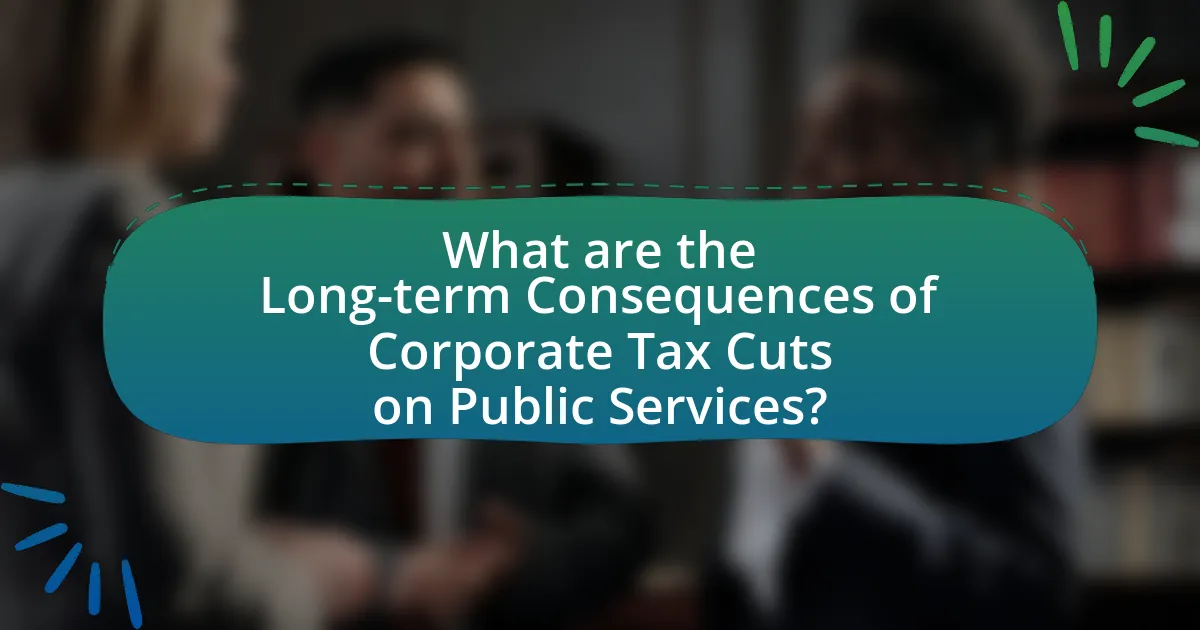
What are the Long-term Consequences of Corporate Tax Cuts on Public Services?
Long-term consequences of corporate tax cuts on public services typically include reduced funding for essential services such as education, healthcare, and infrastructure. When corporations pay lower taxes, governments often face budget shortfalls, leading to cuts in public spending. For instance, a study by the Institute on Taxation and Economic Policy found that states that enacted corporate tax cuts experienced significant declines in public investment, which negatively impacted service quality and availability. Over time, these reductions can exacerbate social inequalities and hinder economic growth, as underfunded public services struggle to meet the needs of the population.
How do corporate tax cuts affect the sustainability of public services?
Corporate tax cuts negatively impact the sustainability of public services by reducing government revenue, which is essential for funding these services. When corporations pay lower taxes, the government collects less money, leading to budget shortfalls that can result in cuts to essential services such as education, healthcare, and infrastructure. For instance, a study by the Institute on Taxation and Economic Policy found that states that implemented significant corporate tax cuts experienced a decline in public investment, which directly correlates with deteriorating public services. This evidence illustrates that reduced corporate taxation can undermine the financial foundation necessary for maintaining robust public services.
What are the risks of underfunding essential services?
Underfunding essential services poses significant risks, including deterioration of public health, increased crime rates, and reduced educational outcomes. When essential services such as healthcare, law enforcement, and education are underfunded, the quality and accessibility of these services decline. For instance, a study by the National Association of State Budget Officers found that states with reduced funding for public health experienced higher rates of preventable diseases and increased healthcare costs. Additionally, underfunding law enforcement can lead to higher crime rates, as police departments may lack the resources necessary for effective community policing. In education, insufficient funding can result in larger class sizes and fewer resources, negatively impacting student performance and future workforce readiness. These risks highlight the critical need for adequate funding to maintain the effectiveness and reliability of essential services.
How do tax cuts influence future policy decisions regarding public services?
Tax cuts influence future policy decisions regarding public services by reducing government revenue, which often leads to budget constraints and prioritization of spending. When tax cuts are implemented, such as the 2017 Tax Cuts and Jobs Act in the United States, they can result in significant decreases in funding for essential services like education, healthcare, and infrastructure. For instance, after the tax cuts, many states faced budget shortfalls, prompting cuts to public services and programs. This trend indicates that policymakers may prioritize tax reductions over public service funding, ultimately affecting the quality and availability of these services for citizens.
What strategies can mitigate the negative effects of corporate tax cuts?
To mitigate the negative effects of corporate tax cuts, governments can implement targeted public investment strategies. These strategies include reallocating funds to essential public services such as education, healthcare, and infrastructure, which can stimulate economic growth and offset potential revenue losses from tax cuts. For instance, research by the International Monetary Fund indicates that public investment can lead to higher long-term economic output, thereby compensating for reduced tax revenues. Additionally, enhancing tax compliance measures and closing loopholes can help maintain revenue levels while ensuring that corporations contribute fairly to public finances.
How can governments balance tax cuts with public service funding?
Governments can balance tax cuts with public service funding by implementing targeted spending cuts, increasing efficiency in public services, and broadening the tax base. Targeted spending cuts allow governments to reduce expenditures in less critical areas while preserving essential services. For instance, a study by the International Monetary Fund in 2021 indicated that countries that streamlined administrative costs could maintain service levels despite reduced tax revenues. Increasing efficiency through technology and process improvements can also help maximize the impact of available funds. Additionally, broadening the tax base by closing loopholes or adjusting tax rates for higher income brackets can generate necessary revenue without significantly burdening lower-income citizens. This multifaceted approach enables governments to maintain essential public services while accommodating tax reductions.
What role do alternative revenue sources play in sustaining public services?
Alternative revenue sources are crucial for sustaining public services, especially in the context of reduced corporate tax revenues. As corporate tax cuts diminish government funding, alternative revenue streams such as fees, grants, and public-private partnerships become essential to maintain service levels. For instance, a report by the Center on Budget and Policy Priorities highlights that states increasingly rely on user fees and taxes on services to offset budget shortfalls caused by tax reductions. This shift underscores the importance of diversifying revenue sources to ensure the continuity and quality of public services.
What lessons can be learned from past corporate tax cut policies?
Past corporate tax cut policies demonstrate that such reductions often do not lead to the anticipated economic growth or job creation. For instance, the 2017 Tax Cuts and Jobs Act in the United States was projected to stimulate investment and wages; however, studies indicated that much of the tax savings were used for stock buybacks rather than employee wages or capital investment. According to a report by the Institute for Policy Studies, 43% of the tax savings were allocated to stock buybacks in the year following the cuts, highlighting a disconnect between tax policy and public benefit. Additionally, these tax cuts frequently result in reduced government revenue, which can lead to cuts in public services, as seen in states like Kansas after significant tax reductions in 2012, where funding for education and infrastructure suffered. Thus, the lessons learned emphasize the need for careful consideration of the broader economic impacts and the potential trade-offs in public service funding when implementing corporate tax cuts.
What case studies illustrate the impact of tax cuts on public services?
Case studies from Kansas and Wisconsin illustrate the impact of tax cuts on public services. In Kansas, significant tax cuts implemented in 2012 led to budget shortfalls, resulting in cuts to education funding and public services. The Kansas Center for Economic Growth reported that school funding decreased by over $500 million from 2015 to 2017 due to these tax policies. Similarly, in Wisconsin, tax cuts enacted in 2013 resulted in a $1 billion budget deficit, prompting reductions in local government funding and public health services, as noted by the Wisconsin Budget Project. These examples demonstrate how tax cuts can adversely affect the availability and quality of public services.
How can these lessons inform future tax policy decisions?
Lessons from the consequences of corporate tax cuts can inform future tax policy decisions by highlighting the need for a balanced approach that considers both revenue generation and public service funding. Evidence shows that significant corporate tax reductions often lead to decreased government revenue, which can adversely affect public services such as education and healthcare. For instance, a study by the Institute on Taxation and Economic Policy found that states that implemented corporate tax cuts experienced budget shortfalls, resulting in cuts to essential services. Therefore, future tax policies should prioritize sustainable revenue sources to ensure the continued provision of public services while fostering economic growth.
